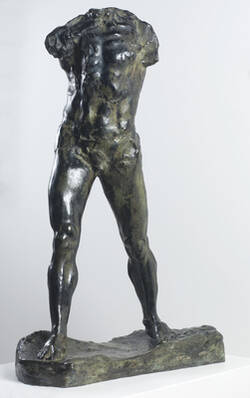The French sculptor Auguste Rodin (1840–1917) was a major pioneer of modernism and set new standards for sculpture.
With "The Walking Man", he tackled one of the oldest problems in the visual arts: the depiction of movement. The striding position of the Walking Man shows both feet on the ground at the same time. However, the foot positions can be seen in succession, forming the beginning and end of the movement. Between foot and foot there is a period of time: the step.
The bronze is a torso, a fragment. Originally, this damaged body belonged to a fully formed figure that Rodin had created twelve years earlier. It was a young, bearded St John the Baptist, from whom Rodin first removed the staff from his right hand. He later removed the head and arms to emphasise the idea of opening up. A person on the move is characterised by demonstrative incompleteness. The reduction of the figure to the torso and legs releases its essence, its vitality. Fragmentation becomes a means of completion.
Weitere Medien
- Ort & Datierung
- 1900
- Material & Technik
- Bronze
- Abmessungen
- 85 x 27,5 x 60 cm
- Museum
- Von der Heydt Museum
- Inventarnummer
- P 0053


